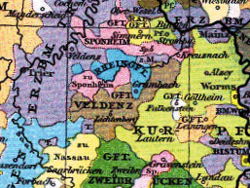Loading AI tools
State in the Holy Roman Empire From Wikipedia, the free encyclopedia
The County Palatine of Veldenz was a principality in the contemporary Land Rhineland-Palatinate with full voting rights to the Reichstag. The county was located partially between Kaiserslautern, Sponheim and Zweibrücken, partially on the Mosel in the Archbishopric of Trier. A municipality of the same name, Veldenz, and a castle, Schloss Veldenz, are located in the district of Bernkastel-Wittlich.
County Palatine of Veldenz | |||||||||
|---|---|---|---|---|---|---|---|---|---|
| 1112–1797 | |||||||||
 Veldenz c. 1400 | |||||||||
| Status | State of the Holy Roman Empire | ||||||||
| Capital | Veldenz | ||||||||
| Common languages | Moselle Franconian | ||||||||
| Government | County | ||||||||
| Historical era | Middle Ages | ||||||||
• Established | 1112 | ||||||||
• Counts of Veldenz-Geroldseck | 1277 | ||||||||
• Inherited by House of Palatinate-Zweibrücken | 1444 | ||||||||
• Joined Upper Rhenish Circle | 1500 | ||||||||
• Counts of Palatinate-Veldenz | 1543 | ||||||||
• To Palatinate-Two Bridges | 1694 | ||||||||
| 1797 | |||||||||
| |||||||||


The Counts of Veldenz separated from the Wildgraves of Kyrburg and Schmidburg family in 1112. The direct male line of the first comital house ceased in 1260 with the death of Gerlach V of Veldenz and his daughter Agnes of Veldenz inherited the county in 1260. Her husband Heinrich of Geroldseck became the founder of the second line of Counts of Veldenz or the House of Veldenz-Geroldseck (Hohengeroldseck).
In 1444 the county came under the rule of Stephen, Count Palatine of Simmern-Zweibrücken by his marriage to Anna of Veldenz, the only heiress of Count Frederick III of Veldenz. As of 1532, the entire County Palantine of Zweibrücken passed to the child Wolfgang. In 1543, when Wolfgang reached majority and took on the responsibilities of office, he enacted the Marburg Contract, giving his uncle Rupert, who had served as his regent and guardian for 11 years, the County of Veldenz.
When Rupert died in 1544, son George John succeeded him as Count Palatine of Veldenz. George married Anna Maria of Sweden, a daughter of Gustav I of Sweden, in 1563. This was the joining of the House of Wittelsbach with the Swedish Vasa royal family which was strengthened by a further marriage when Johann Casimir of Pfalz-Zweibrücken married Catharina of Sweden, a sister of Gustavus Adolphus in the 17th century. Wolfgang had in 1553 with the Heidelberg Succession agreement regulated the mutual inheritance of all Wittelsbach lines reaching from Veldenz-Palatinate to the county Lützelstein in Alsace. The grandson of Georg Hans, Leopold Ludwig von Lützelstein, died in 1694 as a poor man without legitimate offspring and the county-Palatinate of Veldenz, which was in ruins after many French attacks, reverted to the Zweibrücken line, specifically King of Sweden Charles XI, who ruled in personal union with the duchy of Palatine Zweibrücken. However, the bordering Electoral Palatinate also wanted the ruins, which they obtained in 1733.[1]
In 1801 it was incorporated into the Saardepartement of the First French Empire. The Congress of Vienna, 1815, gave the smaller part of the county lying on the Mosel to Prussia and the remainder to Bavaria.
Sweden and the Palatinate disputed the Veldenz ruins for years. When the personal union of Sweden and Zweibrücken ended and following agreements among the Wittelsbach family, Veldenz went to the bordering Electoral Palatinate in 1733.[1]
Seamless Wikipedia browsing. On steroids.
Every time you click a link to Wikipedia, Wiktionary or Wikiquote in your browser's search results, it will show the modern Wikiwand interface.
Wikiwand extension is a five stars, simple, with minimum permission required to keep your browsing private, safe and transparent.